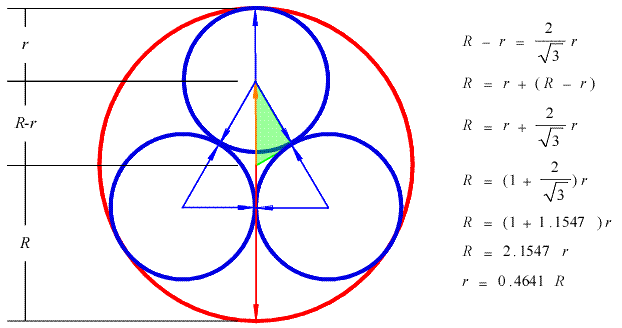You are using an out of date browser. It may not display this or other websites correctly.
You should upgrade or use an alternative browser.
You should upgrade or use an alternative browser.
ch9 table 1
- Thread starter Ponchik
- Start date
- Status
- Not open for further replies.
Volta
Senior Member
- Location
- Columbus, Ohio
With multiple conductors of the same size, when three or more are used to fill up to 40%, they will each neccessarily have a smaller diameter than just two at the smaller percentage. When the two conductors are measured, side-by-side, their diameters will total a large span compared to the smaller wires needed to comply with the 3 @ 40%.
I had to draw it out once to convince myself, looking at the appropriately sized circles on paper made it easy to believe the need.
I had to draw it out once to convince myself, looking at the appropriately sized circles on paper made it easy to believe the need.
bphgravity
Senior Member
- Location
- Florida
Because of the potential for jamming.why does table 1 in chapter 9 restrict the conduit fill to 31% for two conductors and 40% fill for more than 2 conductors?
Thanks
Consider a conductor that has an overall diameter half that of the conduit's inside diameter:
Conduit area: pi*D?/4
Conductor area: pi*(D/2)?/4 = pi*D?/16
Conductor area to conduit area percentage: (pi*D?/16)/(pi*D?/4)*100% = (1/16)/(1/4)*100% = 25%
Conductor area: pi*(D/2)?/4 = pi*D?/16
Conductor area to conduit area percentage: (pi*D?/16)/(pi*D?/4)*100% = (1/16)/(1/4)*100% = 25%
Two such conductors would be 50% fill. Though they would fit in the conduit physically, you would not be able to pull them in through any substantial length of conduit.
Now take into consideration the conductors may twist while pulling them in, and a somewhat oval cross-sectional area through bends in the conduit. At 50%, you would not be able to get two conductors through without deforming or damaging them in some way.
Exactly how the 31% figure was arrived at, I do not know...
There is an FPN to this effect for three conductors for the same reason.
Volta
Senior Member
- Location
- Columbus, Ohio
. . . Exactly how the 31% figure was arrived at, I do not know...
I don't either, but I notice from the 50 and 65% fills you showed in the post referred to above, that 31 and 40% fills are each (about) 62% of the inner circles total areas, respectively.
I don't either, but I notice from the 50 and 65% fills you showed in the post referred to above, that 31 and 40% fills are each (about) 62% of the inner circles total areas, respectively.
That's quite an astute deduction
If you want to get really technical, click here.
jumper
Senior Member
- Location
- 3 Hr 2 Min from Winged Horses
Because it's not a third conductor of the same size. With two conductors the geometric maximum is two of equal (50%) diameter have a 50% fill.Thank you for the replies.
Smart,
Please explain the 50% and the 65% concept. i know i am doing something wrong on my math, because 2 conductors will fill 50%, but why the 3rd conductor only fills an additional 15%?
Thanks
To fit three conductors in a conduit, their diameters must be smaller. That diameter calculates out to be 0.4641 times the inside diameter of the conduit. The ratios would be that of the squares: 3?0.4641?:1? = 0.6461 or roughly 65% (I rounded to the nearest multiple of 5).

lakee911
Senior Member
- Location
- Columbus, OH
If you want to get really technical, click here.
What a great document! Thanks.
- Status
- Not open for further replies.

